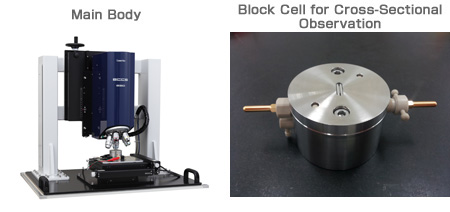New Product : Lasertec Announces ECCS B310 New Electro-Chemical Reaction Visualizing Confocal System
2012.10.23

In-situ visualization and measurement of electro-chemical reactions inside charging / discharging LIB
Yokohama, Japan, October 23, 2012 - Lasertec Corporation today announced Electro-Chemical Reaction Visualizing Confocal System (ECCS for short) with model number B310, designed for in-situ observation and measurement of electro-chemical reactions inside lithium ion batteries (LIBs).
Description
Based on Lasertec's core technology, real-color confocal optics, ECCS B310 visualizes distribution of electro-chemical reactions in electrolyte of charging or discharging LIBs through the window on the observation cells designed especially for in-situ observation. ECCS B310 can provide moving images at variable speeds for easy observation and analysis.
LIBs are widely used today on smartphones, cellular phones, tablet and notebook PCs in compact packaging. As their usages are expanding into more diverse applications including medium to large-sized batteries for electric vehicles and load leveling, LIBs are expected to become more energy efficient with higher energy density and shorter charging time while meeting a higher safety standard. LIB's capabilities depend on a large number of factors, including composition of active materials for cathode, anode and electrolyte, which can be chosen from more than 1,000 different materials, as well as choice of conductive agents for active materials and their dosages. However, evaluation methods hitherto generally available can only measure performance of LIBs based on charging and discharging curves, but cannot visualize electro-chemical reactions inside sealed LIBs.
ECCS B310 provides high-definition color moving images for surface or cross-sectional observation of electrodes in a charging or discharging LIB. Thanks to this capability, ECCS B310 can be used to observe distribution of electro-chemical reactions on the electrodes or throughout the depth of the LIB, to measure expansion and contraction of active materials, and to analyze dendrite formation mechanisms. Therefore, ECCS B310 makes an effective tool for evaluation of LIB performance in various R&D efforts, material property improvement and quality assurance.
Key Features
- High-definition moving images with good color separation provided by real-color confocal optics optimized for in-situ LIB observation, without being affected by glass surfaces or electrolyte
- Real-time observation at industry-leading image capture rates
- 3D measurement of dendrites
- System customization to ensure highest performance in each customer application
Applications
- Visualization of lithium ion intercalation
- Measurement of expansion and contraction of active materials
- Measurement of electrode thickness
- Analysis of dendrite formation mechanisms
<Distribution of Reactions over the Surface of Graphite Anode observed with ECCS B310>

In this example, a graphite anode is observed with ECCS B310 while LIB is being charged. The charge progresses through a couple of stages and reaches Stage 1 where lithium ion is intercalated between all layers. At Stage 1, the color of active materials on the electrode is gold. By observing how active materials change colors from grey to blue, red and finally gold, you can analyze property of the LIB.
